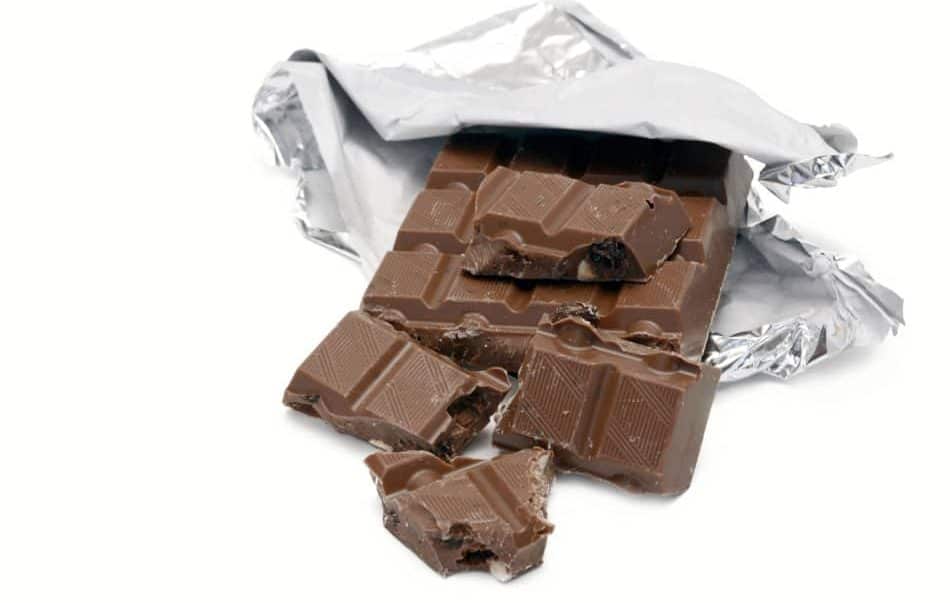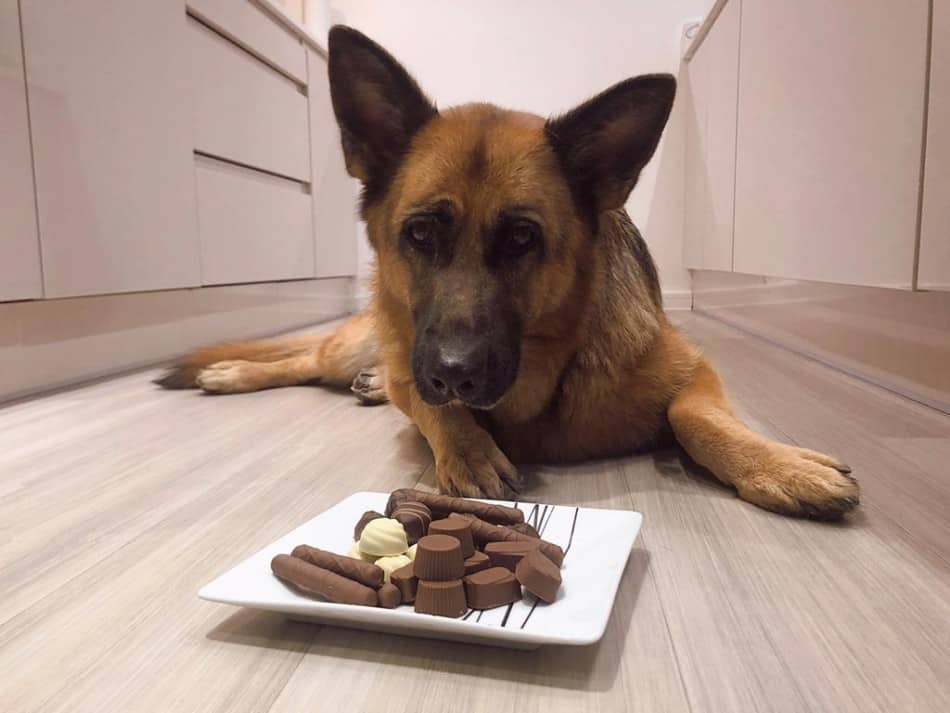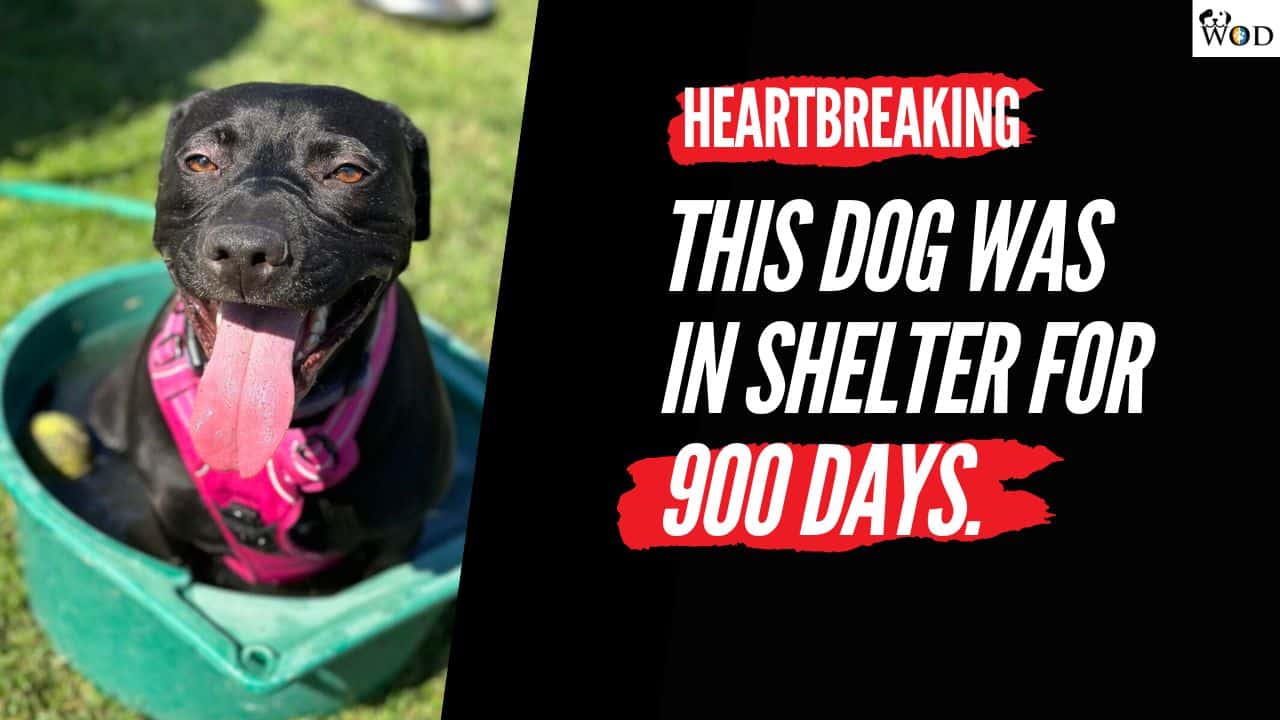Everyone knows how much I like chocolate, from chocolate bars to candies and chocolate ice cream. It’s tempting to give your dog some chocolate when he stares at you with those longing cute puppy eyes, but can German Shepherds eat chocolate?
German Shepherds can not eat chocolate as they cannot metabolize the theobromine it contains, making it toxic. All types of chocolate are toxic; however, the most potent types are dark and unsweetened baking chocolate. Death can occur depending on your dog’s size and how much your dog ate.
I’ll share lots of info about German Shepherds and chocolate in this article. You’ll discover
- How much chocolate is toxic to GSDs.
- Symptoms of chocolate poisoning in dogs.
- What to do if your German Shepherd eats chocolate.
Let’s get started!

Can Chocolate Kill a German Shepherd?
Chocolate is made from seeds (beans) in the pod-like fruit of the Theobroma cacao tree. It is one of the most popular food types and flavors globally. Various chocolate-based products, such as cakes, brownies, and cookies, are available, not to mention the vast selection of chocolate bars and candies.
Chocolate is harmless to humans – other than overeating causing weight gain, but can chocolate kill German Shepherds?
Chocolate can kill a German Shepherd as it contains poisonous compounds, theobromine, and caffeine. These stimulants speed up the heart rate, excite the nervous system, and, as diuretics, remove water from the body. Dogs can not metabolize theobromine which builds up to toxic levels, causing death.
Although theobromine in chocolate is 3-10 times more concentrated than caffeine – both contribute to canine toxicosis.
Humans have a high tolerance for these compounds as we can efficiently metabolize theobromine, but dogs cannot do this. They can only process it more slowly, allowing it to build up to toxic levels. Theobromine is also found in coffee, tea, and cola drinks.
How Much Chocolate Can Kill a German Shepherd?
Here’s the scenario. You come home from work to find an empty chocolate wrapper on the kitchen floor. You don’t have children, so you suddenly realize it can only be your German Shepherd who has somehow managed to find it. In a moment of panic, your first thought is how much chocolate can kill a German Shepherd?
The amount of chocolate that can kill a German Shepherd depends on the type ingested (dark is more toxic than white), the quantity, and the dog’s weight. A German Shepherd weighing 88 lb (40kg) could die after eating just 9.25 ozs (260g) of the more potent baker’s (unsweetened) chocolate.
Learn More on Why Dogs Can’t Eat Chocolate…
Here are the main types of chocolate and chocolate products that are dangerous for your German Shepherd:
- Baking (unsweetened) chocolate
- Dark chocolate
- Cocoa (cacao) beans
- Semi-sweet chocolate
- Milk chocolate
- White chocolate
- Hot chocolate
- Chocolate cake, cookies, candies, etc
As mentioned earlier, different types of chocolate have different potency levels; baking chocolate, dark chocolate, and cocoa are the most dangerous for your German Shepherd, while white chocolate is the least.
White chocolate contains very little theobromine, and although your German Shepherd would have to eat a substantial amount to cause poisoning, it is still high in fat which can make your dog quite ill and trigger pancreatitis.
Therefore, the darker and more bitter the chocolate, the greater the risk. Your dog could get sick or die from eating a small amount of baker’s chocolate, but eating an equivalent amount of milk chocolate (mainly sugar and fat) may produce mild or no symptoms.
These are the approximate amounts of theobromine that is present in the below types of chocolate per ounce:
- Baking Chocolate 450 mg
- Dark chocolate 300 mg
- Semi-sweet chocolate 260 mg
- Milk chocolate 60 mg
- White chocolate 1 mg

Let’s delve further…
So now we know which TYPES OF CHOCOLATE are the most toxic; exactly HOW MUCH IS TOXIC for your German Shepherd (or any other breed)?
Well, this all depends on the weight of your dog. The weight of a German Shepherd can vary from a small female of 49 lbs (22 kg) to a large male weighing over 88 lbs (40 kg). Therefore, a 6 lb Yorkshire Terrier that eats one ounce of dark chocolate is at greater risk of toxicity than a 75 lb German Shepherd that eats the same amount.
According to the Merck Veterinary Manual, just one ounce of milk chocolate per pound of body weight is a potentially lethal dose in dogs.
Check out the below chocolate toxicity calculator. I learned that my German Shepherd, who weighs 88 lb (40kg), would have to eat 12.5 ounces (around 350g) of milk chocolate to require medical attention.
This is quite a large-sized block. However, should she have consumed the more toxic baker’s (unsweetened) chocolate, then she would only have to eat 2 ounces (around 50g) to require the same medical attention and only 3.75 ounces (about 100g) to require emergency treatment. Consuming 9.25 ounces (about 260g) could result in her death.
It wouldn’t take much of the more potent types of chocolate from these frightening facts to cause severe harm or worse to a toy or small breed dog.
If you are curious like me, go check out the calculator to see how much your dog would have to eat of each different type of chocolate to cause an emergency.
Some types of chocolate also contain xylitol (sweetener), an additional poison for your dog.
And don’t even think of letting your dog near chocolate-coated nuts, especially macadamia and walnuts, as both contain an unknown toxin.
Here, you can find out what other foods are poisonous to German Shepherds, including one or two hidden dangers that you would never have even thought of!
How Long Does it Take for Chocolate to Affect a Dog?
It can take 6-12 hours for chocolate poisoning to affect a dog. However, some dogs may display symptoms within 2 hours of eating chocolate, whereas, with others, it can take as long as 24 hours due to the theobromine metabolizing slowly. Symptoms can last up to 72 hours.
You mustn’t wait for symptoms to appear – contact your vet immediately for advice.
If you catch your German Shepherd red-handed, quickly remove any chocolate out the way, and try to retrieve any remaining chocolate from his mouth. However, do not try to stick your finger’s down your dog’s throat, as this is dangerous and can make things worse!

There are alternate safe doggy chocolate products that you can buy. These don’t contain caffeine or the deadly, poisonous, very toxic theobromine that chocolate contains. My German Shepherd loves them.
Symptoms of Chocolate Poisoning in Dogs?
Here is a list of symptoms that your German Shepherd may experience from chocolate poisoning:
- Vomiting
- Diarrhea
- Panting
- Excessive thirst
- Hyperactivity
- Excitability
- Twitching
- Lethargy
- Abnormal heart rhythm
- Tremors
- Seizure
Death can occur due to heart problems, hyperthermia, or respiratory failure.
What To Do if German Shepherd Eats Chocolate
Early intervention and treatment can make a difference in saving your German Shepherd’s life. If you believe your dog has eaten chocolate, you must contact your vet as a matter of emergency. Pet Poison Helpline and ASPCA (Animal Poison Control Center) are also available for advice 24 hours a day.
The sooner your dog is diagnosed, the better chance they have and the less expensive it will be for you – unless you have a good pet insurance plan in place.
Your veterinarian will want to know:
- What type of chocolate your dog ate.
- How much chocolate your dog ate.
- How long since your dog ate the chocolate.
- Whether your dog is displaying any symptoms.
Try to give as much information as possible as this will help with any treatment and subsequent prognosis. If you are unsure, try to estimate as best you can.
If your German Shepherd has eaten chocolate within the past two hours, your vet may tell you to induce vomiting to get rid of the poison. If it has been longer than two hours, your dog may need more intensive treatment as below:
- Induce vomiting (depending on when the chocolate was eaten).
- Giving activated charcoal – to bind to the chocolate from the stomach and intestines.
- IV fluid therapy.
- Giving cardiac medications.
- Control seizure activity and elevated heart rate as needed.
- Careful monitoring.
- Bland diet.
Never induce vomiting unless a vet tells you to do so because sometimes you can cause more injury or harm. You must follow the correct instructions and not try crazy and dangerous remedies like sticking your finger down your dog’s throat or giving mustard or salt!
Vets will only recommend inducing vomiting at home in the below situations, as advised by Dr. Justine A. Lee (veterinary specialist and toxicologist) from Pet Health Network:
- If the toxic substance (e.g., chocolate) was only recently ingested.
- If your dog is not yet showing any signs of the poisoning.
- If your dog is healthy and isn’t at risk of inhaling the vomit into their lungs.
The only safe and recommended substance to induce vomiting is 3% hydrogen peroxide. If you don’t have any handy at home, you can obtain it from your local drug store. So, how much hydrogen peroxide should you give?
“In general, the dose of hydrogen peroxide in dogs is approximately 0.5 – 1 ml per pound weight. If your dog weighs 50 pounds, you can give 25 – 50 mls of fresh, non-expired hydrogen peroxide orally, once.”
Dr. Justine A Lee DVM, DACVECC
Keep in mind that 15mls = 1 tablespoon (or 5mls = 1 teaspoon), so the example above would be approximately 1.5 – 3.5 tablespoons.
Prevention is the best advice. Keep all types of chocolate out of the reach of your German Shepherd, especially around the holiday season. Please don’t put them under your Christmas tree!
According to the American Kennel Club, at Christmas, dogs are four times more likely to be taken to the vet with chocolate poisoning than at any other time of the year:
“Each year, reports of dogs with chocolate poisoning increase dramatically around Christmas and Easter. During these periods take extra care to ensure that all chocolate is kept out of the reach of your dog.”
American Kennel Club
You can also teach your dog the command, “LEAVE IT!” This command effectively prevents your dog from eating something that falls to the floor. It’s also a straightforward command to teach.
Check out the below video for a complete list of dangerous foods for your German Shepherd:
Final Thoughts
You now know that your German Shepherd can’t eat chocolate, and you now know what to do in the event of accidental poisoning. Recovery from chocolate toxicity depends on the severity and how soon you started treatment.
However, you shouldn’t be worried as your doggo can make a complete recovery. The prognosis is good if the poisoning is caught and treated early, i.e., within 2 hours of eating the chocolate.
Recovery time can take up to three days. Don’t forget to remind guests of your home of the dangers, as not all visitors will be familiar with dogs.
Related Posts You May Like:






